Accounting Assignment: AASB 16, AASB 15, and Financial Statements
VerifiedAdded on 2021/05/31
|12
|1961
|218
Homework Assignment
AI Summary
This accounting assignment is divided into three parts. Part A examines AASB 16, focusing on its impact on balance sheets, assets, liabilities, and equity, and its consistency with the IASB's conceptual framework. Part B explores AASB 15 on revenue recognition, including its five-step model, and how positive accounting theory, specifically the debt covenant hypothesis, influences accounting policy choices, illustrated by Microsoft's revenue recognition changes. Part C presents the trial balance, statement of comprehensive income, statement of changes in equity, and balance sheet of NewSpace Ltd, along with notes to the accounts, covering accounting policies, revenue, expenses, receivables, cash, investments, property, plant, equipment, and loans. The assignment integrates financial reporting standards and accounting principles, providing a comprehensive analysis of financial statement preparation and the effects of accounting standards on business decisions.
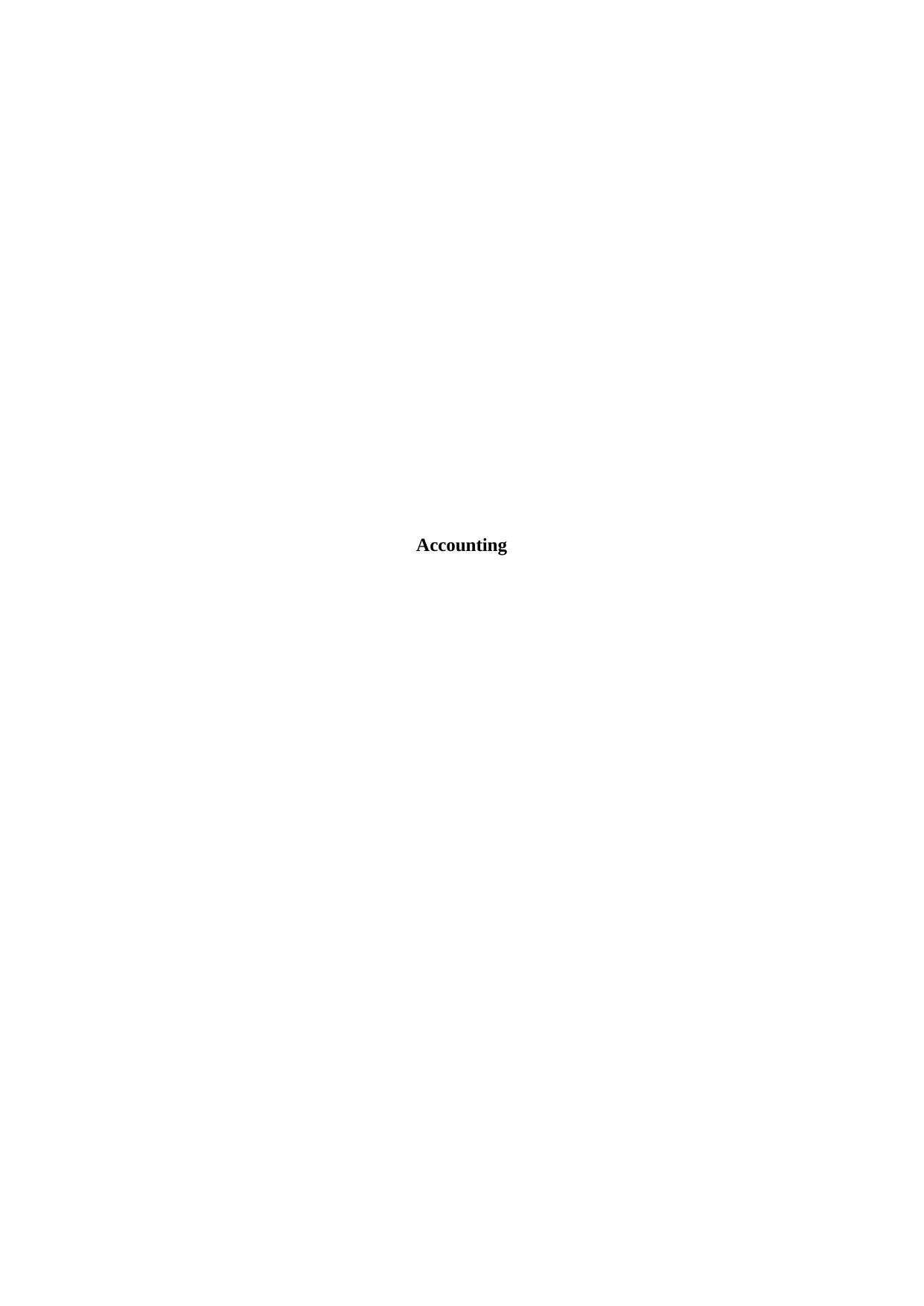
Accounting
Paraphrase This Document
Need a fresh take? Get an instant paraphrase of this document with our AI Paraphraser
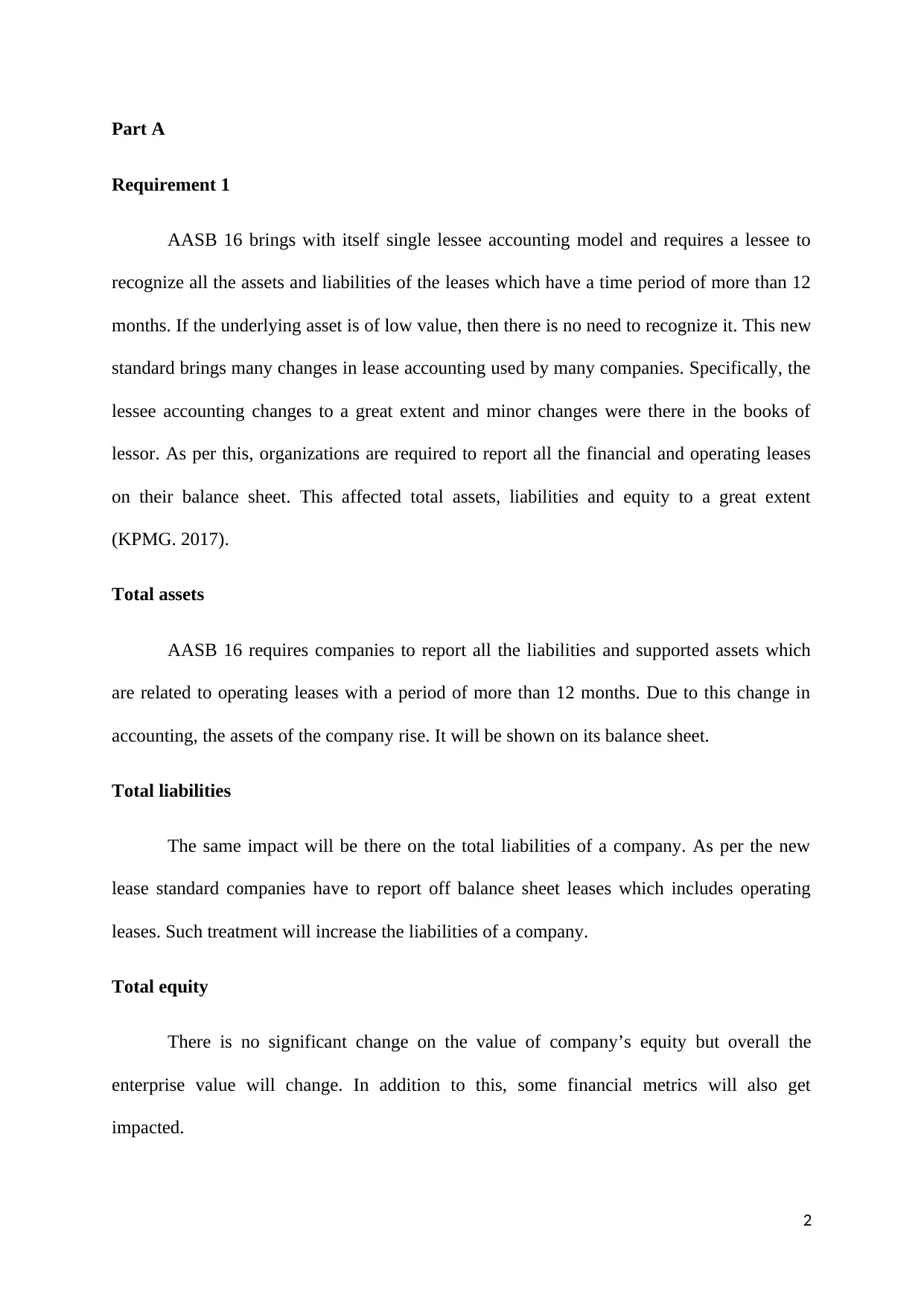
Part A
Requirement 1
AASB 16 brings with itself single lessee accounting model and requires a lessee to
recognize all the assets and liabilities of the leases which have a time period of more than 12
months. If the underlying asset is of low value, then there is no need to recognize it. This new
standard brings many changes in lease accounting used by many companies. Specifically, the
lessee accounting changes to a great extent and minor changes were there in the books of
lessor. As per this, organizations are required to report all the financial and operating leases
on their balance sheet. This affected total assets, liabilities and equity to a great extent
(KPMG. 2017).
Total assets
AASB 16 requires companies to report all the liabilities and supported assets which
are related to operating leases with a period of more than 12 months. Due to this change in
accounting, the assets of the company rise. It will be shown on its balance sheet.
Total liabilities
The same impact will be there on the total liabilities of a company. As per the new
lease standard companies have to report off balance sheet leases which includes operating
leases. Such treatment will increase the liabilities of a company.
Total equity
There is no significant change on the value of company’s equity but overall the
enterprise value will change. In addition to this, some financial metrics will also get
impacted.
2
Requirement 1
AASB 16 brings with itself single lessee accounting model and requires a lessee to
recognize all the assets and liabilities of the leases which have a time period of more than 12
months. If the underlying asset is of low value, then there is no need to recognize it. This new
standard brings many changes in lease accounting used by many companies. Specifically, the
lessee accounting changes to a great extent and minor changes were there in the books of
lessor. As per this, organizations are required to report all the financial and operating leases
on their balance sheet. This affected total assets, liabilities and equity to a great extent
(KPMG. 2017).
Total assets
AASB 16 requires companies to report all the liabilities and supported assets which
are related to operating leases with a period of more than 12 months. Due to this change in
accounting, the assets of the company rise. It will be shown on its balance sheet.
Total liabilities
The same impact will be there on the total liabilities of a company. As per the new
lease standard companies have to report off balance sheet leases which includes operating
leases. Such treatment will increase the liabilities of a company.
Total equity
There is no significant change on the value of company’s equity but overall the
enterprise value will change. In addition to this, some financial metrics will also get
impacted.
2
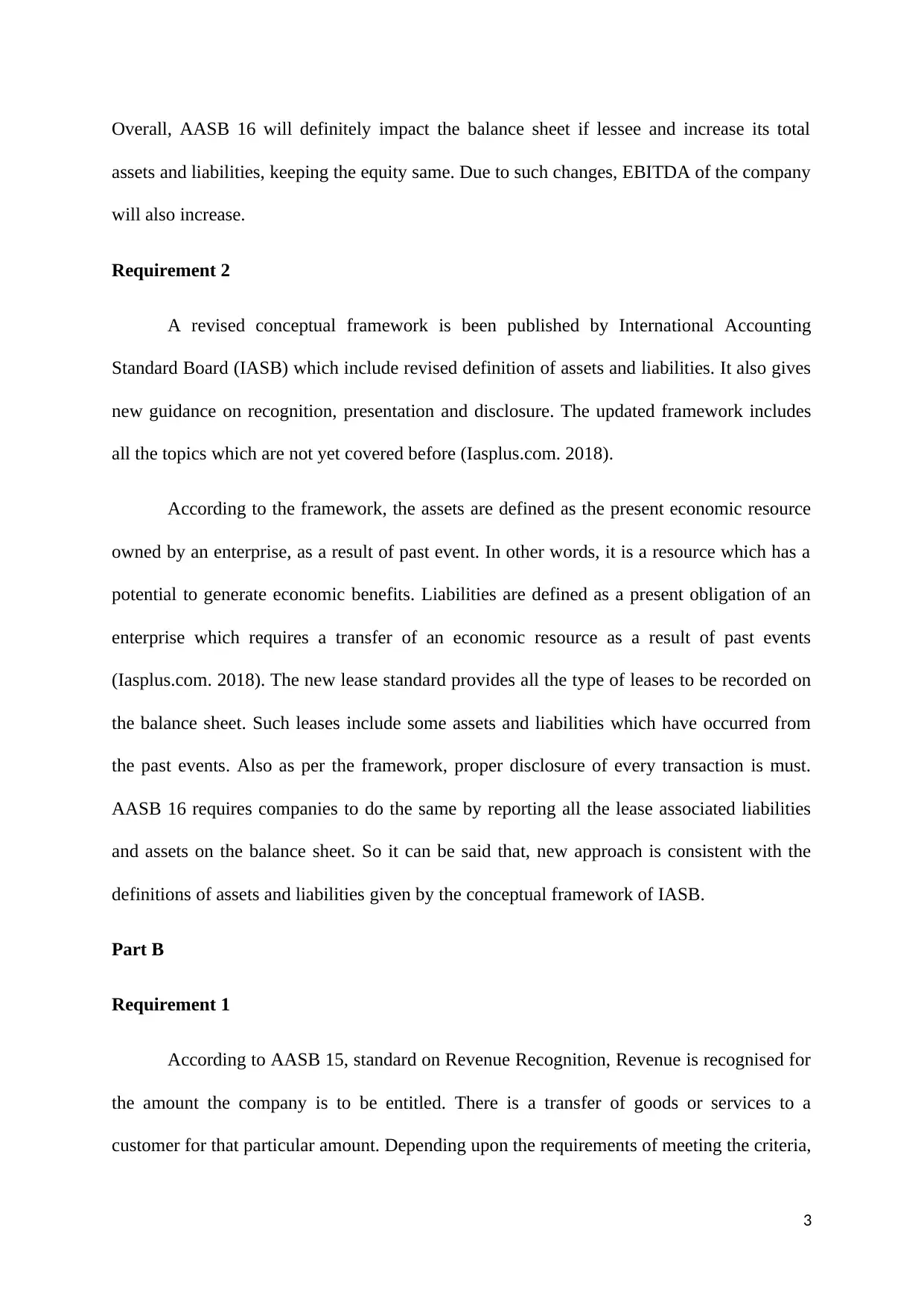
Overall, AASB 16 will definitely impact the balance sheet if lessee and increase its total
assets and liabilities, keeping the equity same. Due to such changes, EBITDA of the company
will also increase.
Requirement 2
A revised conceptual framework is been published by International Accounting
Standard Board (IASB) which include revised definition of assets and liabilities. It also gives
new guidance on recognition, presentation and disclosure. The updated framework includes
all the topics which are not yet covered before (Iasplus.com. 2018).
According to the framework, the assets are defined as the present economic resource
owned by an enterprise, as a result of past event. In other words, it is a resource which has a
potential to generate economic benefits. Liabilities are defined as a present obligation of an
enterprise which requires a transfer of an economic resource as a result of past events
(Iasplus.com. 2018). The new lease standard provides all the type of leases to be recorded on
the balance sheet. Such leases include some assets and liabilities which have occurred from
the past events. Also as per the framework, proper disclosure of every transaction is must.
AASB 16 requires companies to do the same by reporting all the lease associated liabilities
and assets on the balance sheet. So it can be said that, new approach is consistent with the
definitions of assets and liabilities given by the conceptual framework of IASB.
Part B
Requirement 1
According to AASB 15, standard on Revenue Recognition, Revenue is recognised for
the amount the company is to be entitled. There is a transfer of goods or services to a
customer for that particular amount. Depending upon the requirements of meeting the criteria,
3
assets and liabilities, keeping the equity same. Due to such changes, EBITDA of the company
will also increase.
Requirement 2
A revised conceptual framework is been published by International Accounting
Standard Board (IASB) which include revised definition of assets and liabilities. It also gives
new guidance on recognition, presentation and disclosure. The updated framework includes
all the topics which are not yet covered before (Iasplus.com. 2018).
According to the framework, the assets are defined as the present economic resource
owned by an enterprise, as a result of past event. In other words, it is a resource which has a
potential to generate economic benefits. Liabilities are defined as a present obligation of an
enterprise which requires a transfer of an economic resource as a result of past events
(Iasplus.com. 2018). The new lease standard provides all the type of leases to be recorded on
the balance sheet. Such leases include some assets and liabilities which have occurred from
the past events. Also as per the framework, proper disclosure of every transaction is must.
AASB 16 requires companies to do the same by reporting all the lease associated liabilities
and assets on the balance sheet. So it can be said that, new approach is consistent with the
definitions of assets and liabilities given by the conceptual framework of IASB.
Part B
Requirement 1
According to AASB 15, standard on Revenue Recognition, Revenue is recognised for
the amount the company is to be entitled. There is a transfer of goods or services to a
customer for that particular amount. Depending upon the requirements of meeting the criteria,
3
⊘ This is a preview!⊘
Do you want full access?
Subscribe today to unlock all pages.

Trusted by 1+ million students worldwide
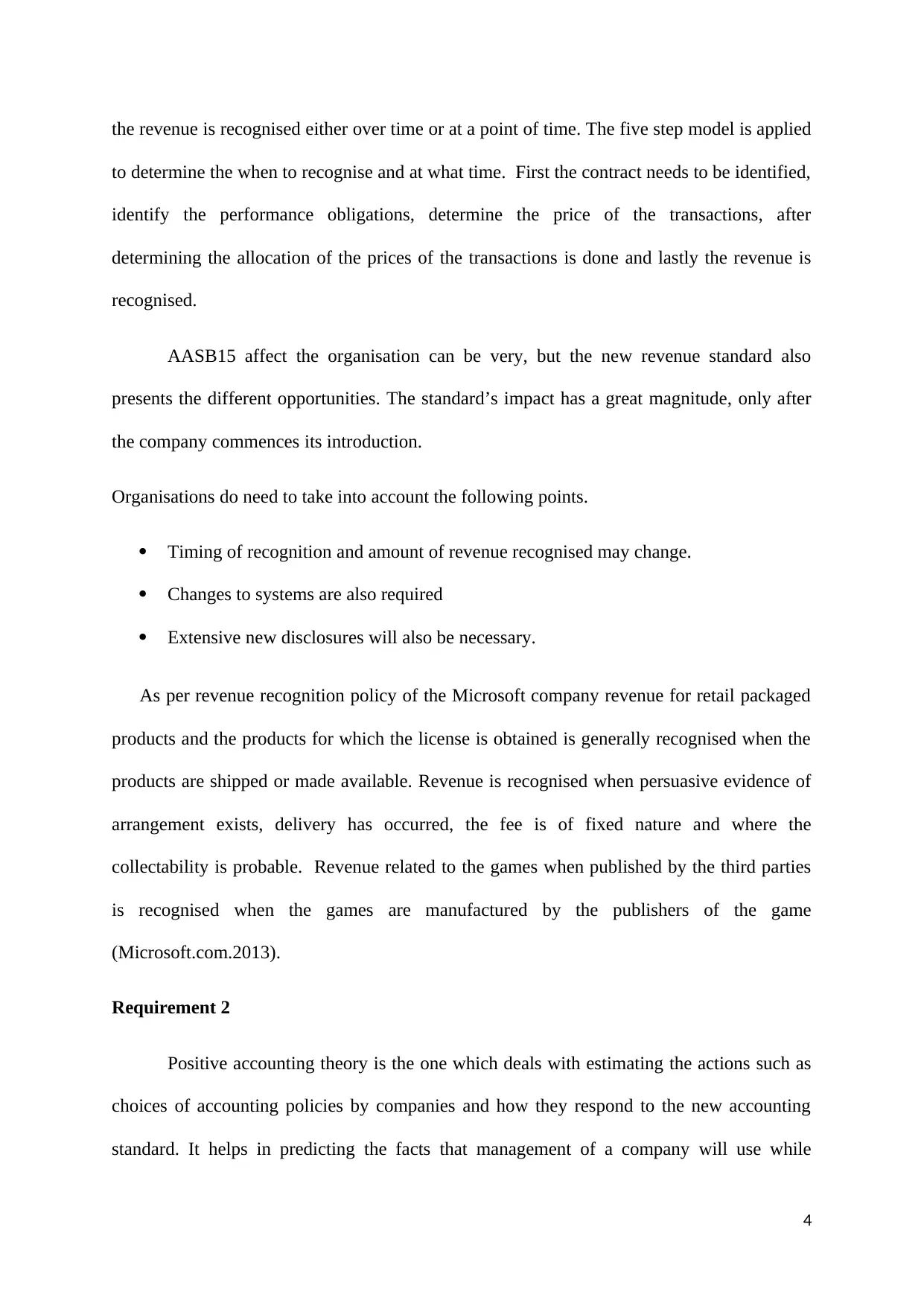
the revenue is recognised either over time or at a point of time. The five step model is applied
to determine the when to recognise and at what time. First the contract needs to be identified,
identify the performance obligations, determine the price of the transactions, after
determining the allocation of the prices of the transactions is done and lastly the revenue is
recognised.
AASB15 affect the organisation can be very, but the new revenue standard also
presents the different opportunities. The standard’s impact has a great magnitude, only after
the company commences its introduction.
Organisations do need to take into account the following points.
Timing of recognition and amount of revenue recognised may change.
Changes to systems are also required
Extensive new disclosures will also be necessary.
As per revenue recognition policy of the Microsoft company revenue for retail packaged
products and the products for which the license is obtained is generally recognised when the
products are shipped or made available. Revenue is recognised when persuasive evidence of
arrangement exists, delivery has occurred, the fee is of fixed nature and where the
collectability is probable. Revenue related to the games when published by the third parties
is recognised when the games are manufactured by the publishers of the game
(Microsoft.com.2013).
Requirement 2
Positive accounting theory is the one which deals with estimating the actions such as
choices of accounting policies by companies and how they respond to the new accounting
standard. It helps in predicting the facts that management of a company will use while
4
to determine the when to recognise and at what time. First the contract needs to be identified,
identify the performance obligations, determine the price of the transactions, after
determining the allocation of the prices of the transactions is done and lastly the revenue is
recognised.
AASB15 affect the organisation can be very, but the new revenue standard also
presents the different opportunities. The standard’s impact has a great magnitude, only after
the company commences its introduction.
Organisations do need to take into account the following points.
Timing of recognition and amount of revenue recognised may change.
Changes to systems are also required
Extensive new disclosures will also be necessary.
As per revenue recognition policy of the Microsoft company revenue for retail packaged
products and the products for which the license is obtained is generally recognised when the
products are shipped or made available. Revenue is recognised when persuasive evidence of
arrangement exists, delivery has occurred, the fee is of fixed nature and where the
collectability is probable. Revenue related to the games when published by the third parties
is recognised when the games are manufactured by the publishers of the game
(Microsoft.com.2013).
Requirement 2
Positive accounting theory is the one which deals with estimating the actions such as
choices of accounting policies by companies and how they respond to the new accounting
standard. It helps in predicting the facts that management of a company will use while
4
Paraphrase This Document
Need a fresh take? Get an instant paraphrase of this document with our AI Paraphraser
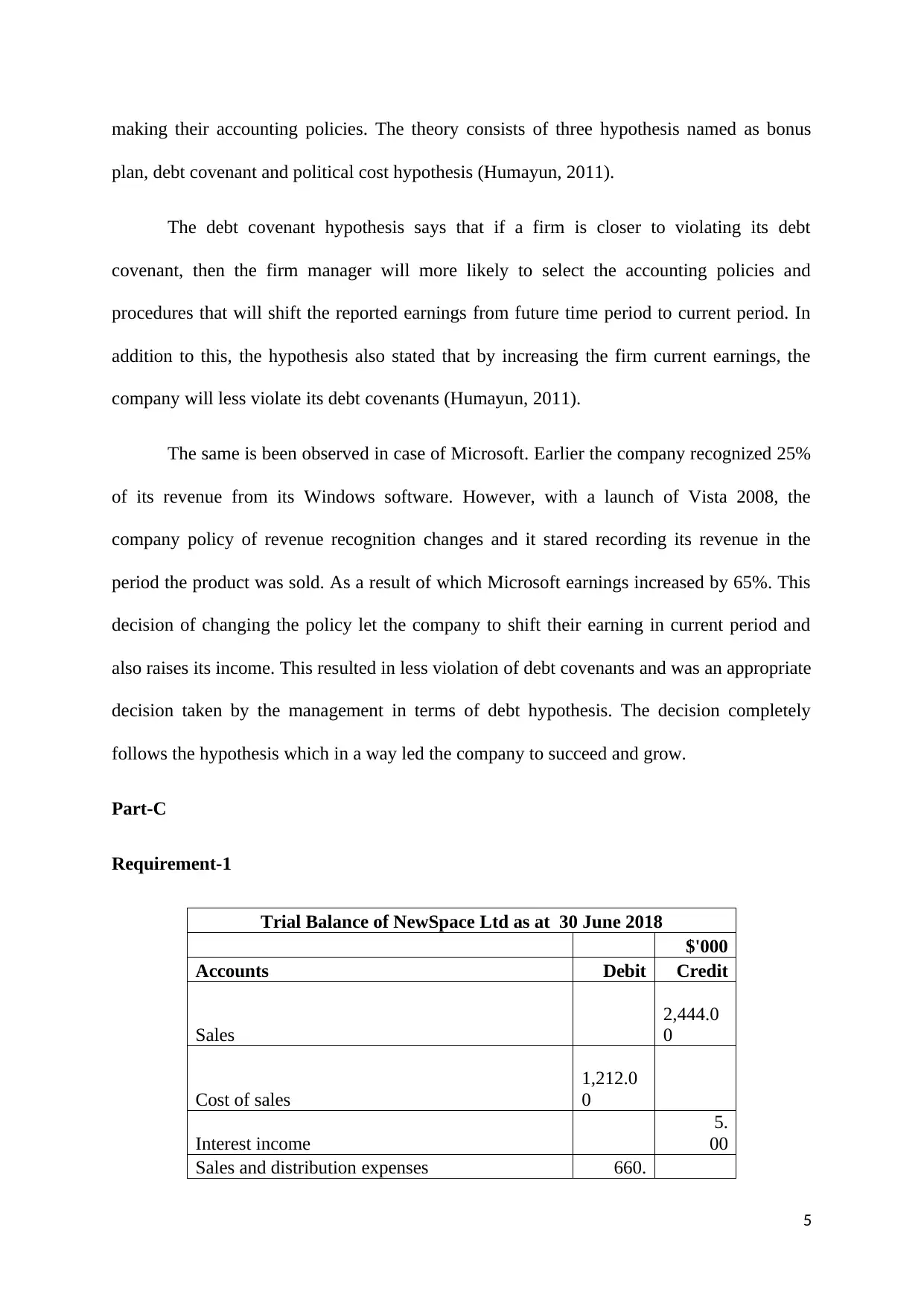
making their accounting policies. The theory consists of three hypothesis named as bonus
plan, debt covenant and political cost hypothesis (Humayun, 2011).
The debt covenant hypothesis says that if a firm is closer to violating its debt
covenant, then the firm manager will more likely to select the accounting policies and
procedures that will shift the reported earnings from future time period to current period. In
addition to this, the hypothesis also stated that by increasing the firm current earnings, the
company will less violate its debt covenants (Humayun, 2011).
The same is been observed in case of Microsoft. Earlier the company recognized 25%
of its revenue from its Windows software. However, with a launch of Vista 2008, the
company policy of revenue recognition changes and it stared recording its revenue in the
period the product was sold. As a result of which Microsoft earnings increased by 65%. This
decision of changing the policy let the company to shift their earning in current period and
also raises its income. This resulted in less violation of debt covenants and was an appropriate
decision taken by the management in terms of debt hypothesis. The decision completely
follows the hypothesis which in a way led the company to succeed and grow.
Part-C
Requirement-1
Trial Balance of NewSpace Ltd as at 30 June 2018
$'000
Accounts Debit Credit
Sales
2,444.0
0
Cost of sales
1,212.0
0
Interest income
5.
00
Sales and distribution expenses 660.
5
plan, debt covenant and political cost hypothesis (Humayun, 2011).
The debt covenant hypothesis says that if a firm is closer to violating its debt
covenant, then the firm manager will more likely to select the accounting policies and
procedures that will shift the reported earnings from future time period to current period. In
addition to this, the hypothesis also stated that by increasing the firm current earnings, the
company will less violate its debt covenants (Humayun, 2011).
The same is been observed in case of Microsoft. Earlier the company recognized 25%
of its revenue from its Windows software. However, with a launch of Vista 2008, the
company policy of revenue recognition changes and it stared recording its revenue in the
period the product was sold. As a result of which Microsoft earnings increased by 65%. This
decision of changing the policy let the company to shift their earning in current period and
also raises its income. This resulted in less violation of debt covenants and was an appropriate
decision taken by the management in terms of debt hypothesis. The decision completely
follows the hypothesis which in a way led the company to succeed and grow.
Part-C
Requirement-1
Trial Balance of NewSpace Ltd as at 30 June 2018
$'000
Accounts Debit Credit
Sales
2,444.0
0
Cost of sales
1,212.0
0
Interest income
5.
00
Sales and distribution expenses 660.
5
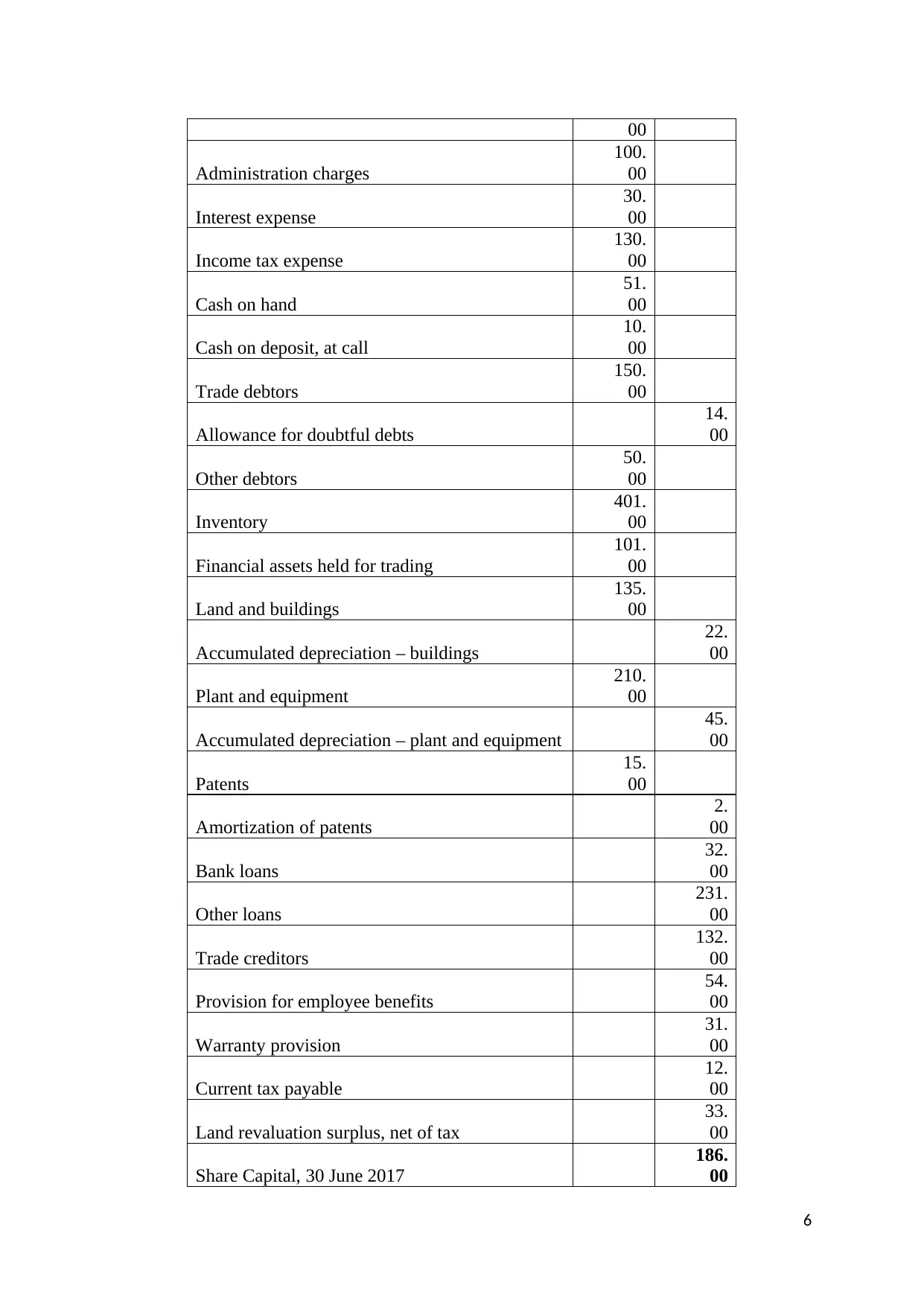
00
Administration charges
100.
00
Interest expense
30.
00
Income tax expense
130.
00
Cash on hand
51.
00
Cash on deposit, at call
10.
00
Trade debtors
150.
00
Allowance for doubtful debts
14.
00
Other debtors
50.
00
Inventory
401.
00
Financial assets held for trading
101.
00
Land and buildings
135.
00
Accumulated depreciation – buildings
22.
00
Plant and equipment
210.
00
Accumulated depreciation – plant and equipment
45.
00
Patents
15.
00
Amortization of patents
2.
00
Bank loans
32.
00
Other loans
231.
00
Trade creditors
132.
00
Provision for employee benefits
54.
00
Warranty provision
31.
00
Current tax payable
12.
00
Land revaluation surplus, net of tax
33.
00
Share Capital, 30 June 2017
186.
00
6
Administration charges
100.
00
Interest expense
30.
00
Income tax expense
130.
00
Cash on hand
51.
00
Cash on deposit, at call
10.
00
Trade debtors
150.
00
Allowance for doubtful debts
14.
00
Other debtors
50.
00
Inventory
401.
00
Financial assets held for trading
101.
00
Land and buildings
135.
00
Accumulated depreciation – buildings
22.
00
Plant and equipment
210.
00
Accumulated depreciation – plant and equipment
45.
00
Patents
15.
00
Amortization of patents
2.
00
Bank loans
32.
00
Other loans
231.
00
Trade creditors
132.
00
Provision for employee benefits
54.
00
Warranty provision
31.
00
Current tax payable
12.
00
Land revaluation surplus, net of tax
33.
00
Share Capital, 30 June 2017
186.
00
6
⊘ This is a preview!⊘
Do you want full access?
Subscribe today to unlock all pages.

Trusted by 1+ million students worldwide
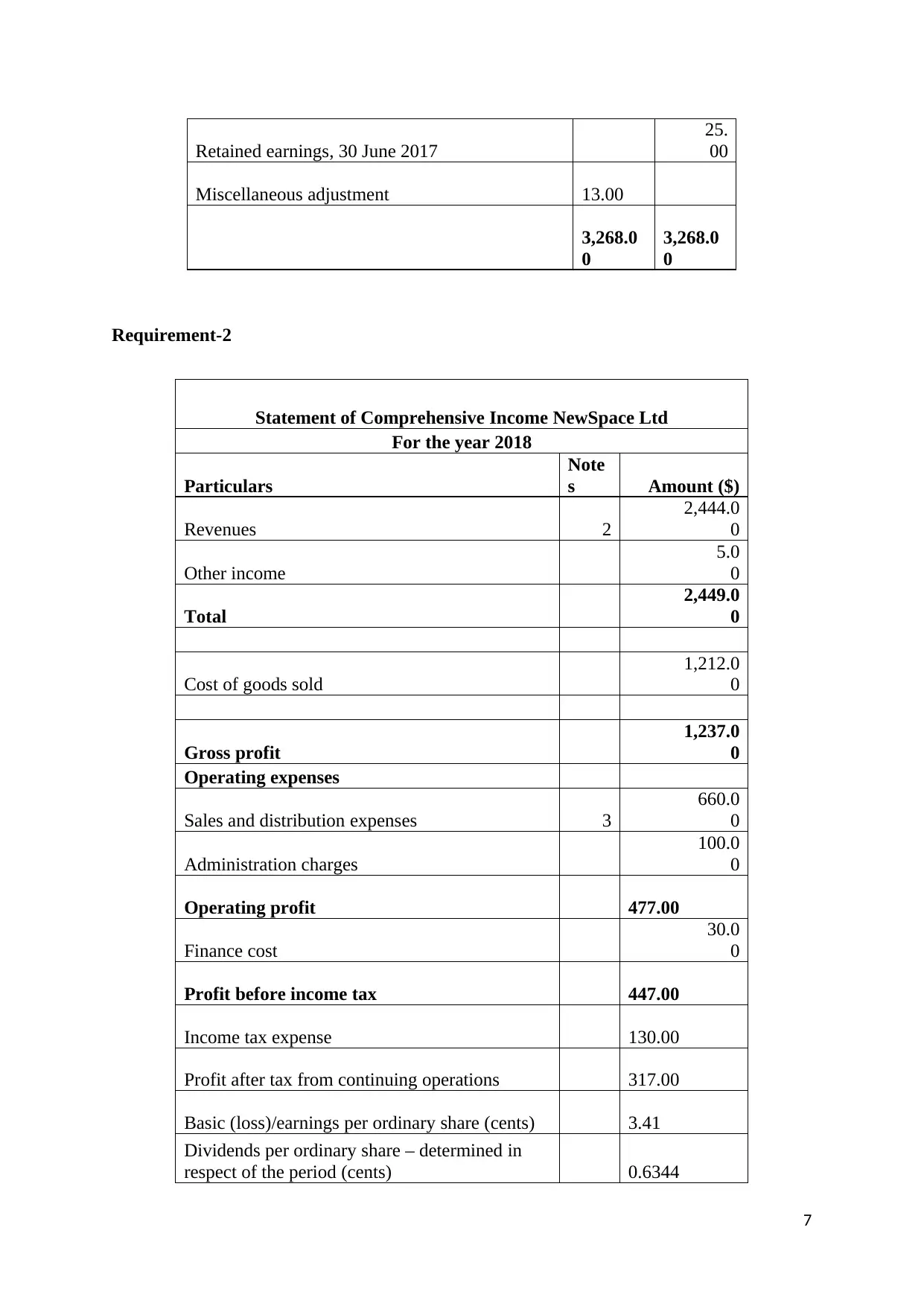
Retained earnings, 30 June 2017
25.
00
Miscellaneous adjustment 13.00
3,268.0
0
3,268.0
0
Requirement-2
Statement of Comprehensive Income NewSpace Ltd
For the year 2018
Particulars
Note
s Amount ($)
Revenues 2
2,444.0
0
Other income
5.0
0
Total
2,449.0
0
Cost of goods sold
1,212.0
0
Gross profit
1,237.0
0
Operating expenses
Sales and distribution expenses 3
660.0
0
Administration charges
100.0
0
Operating profit 477.00
Finance cost
30.0
0
Profit before income tax 447.00
Income tax expense 130.00
Profit after tax from continuing operations 317.00
Basic (loss)/earnings per ordinary share (cents) 3.41
Dividends per ordinary share – determined in
respect of the period (cents) 0.6344
7
25.
00
Miscellaneous adjustment 13.00
3,268.0
0
3,268.0
0
Requirement-2
Statement of Comprehensive Income NewSpace Ltd
For the year 2018
Particulars
Note
s Amount ($)
Revenues 2
2,444.0
0
Other income
5.0
0
Total
2,449.0
0
Cost of goods sold
1,212.0
0
Gross profit
1,237.0
0
Operating expenses
Sales and distribution expenses 3
660.0
0
Administration charges
100.0
0
Operating profit 477.00
Finance cost
30.0
0
Profit before income tax 447.00
Income tax expense 130.00
Profit after tax from continuing operations 317.00
Basic (loss)/earnings per ordinary share (cents) 3.41
Dividends per ordinary share – determined in
respect of the period (cents) 0.6344
7
Paraphrase This Document
Need a fresh take? Get an instant paraphrase of this document with our AI Paraphraser
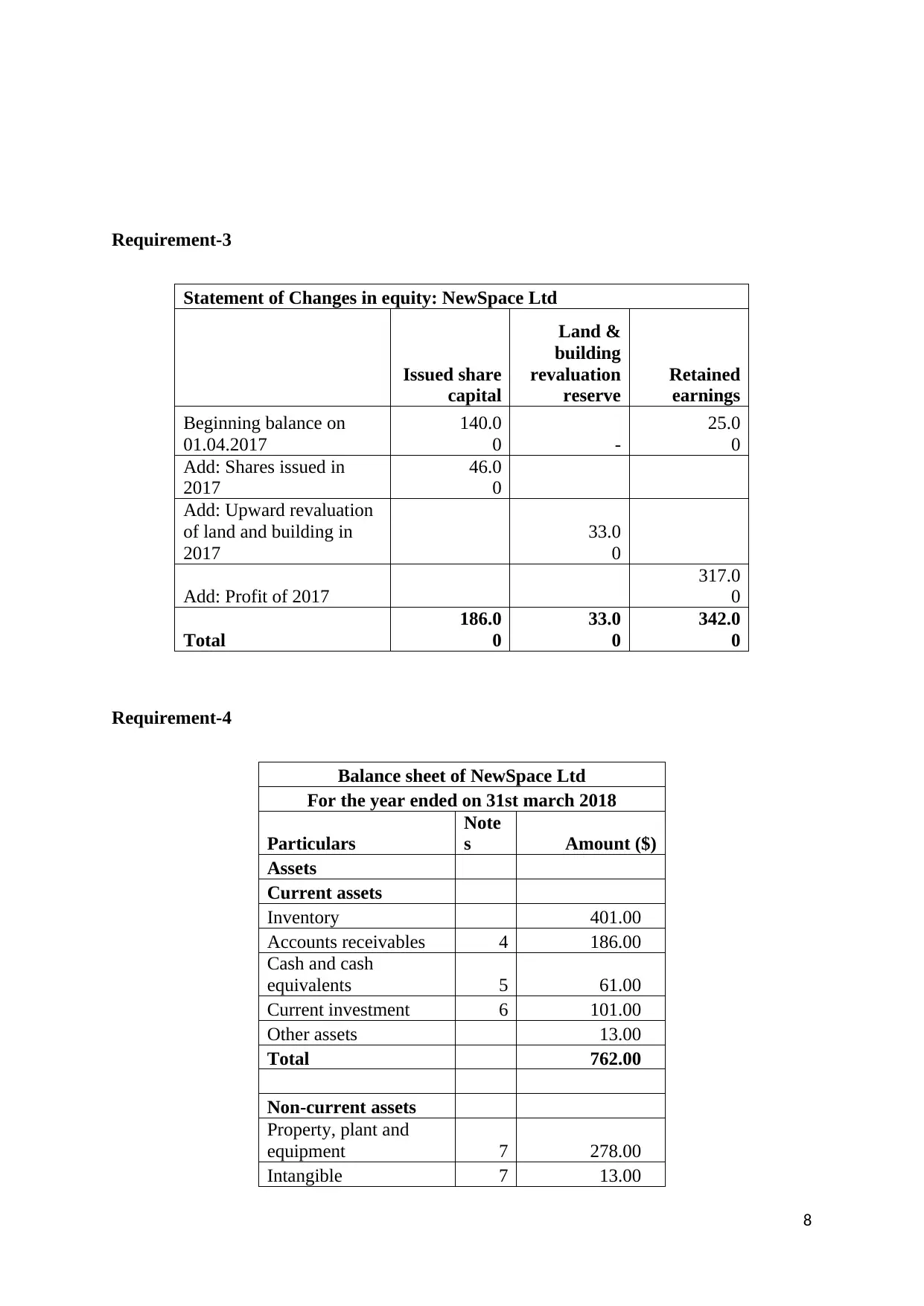
Requirement-3
Statement of Changes in equity: NewSpace Ltd
Issued share
capital
Land &
building
revaluation
reserve
Retained
earnings
Beginning balance on
01.04.2017
140.0
0 -
25.0
0
Add: Shares issued in
2017
46.0
0
Add: Upward revaluation
of land and building in
2017
33.0
0
Add: Profit of 2017
317.0
0
Total
186.0
0
33.0
0
342.0
0
Requirement-4
Balance sheet of NewSpace Ltd
For the year ended on 31st march 2018
Particulars
Note
s Amount ($)
Assets
Current assets
Inventory 401.00
Accounts receivables 4 186.00
Cash and cash
equivalents 5 61.00
Current investment 6 101.00
Other assets 13.00
Total 762.00
Non-current assets
Property, plant and
equipment 7 278.00
Intangible 7 13.00
8
Statement of Changes in equity: NewSpace Ltd
Issued share
capital
Land &
building
revaluation
reserve
Retained
earnings
Beginning balance on
01.04.2017
140.0
0 -
25.0
0
Add: Shares issued in
2017
46.0
0
Add: Upward revaluation
of land and building in
2017
33.0
0
Add: Profit of 2017
317.0
0
Total
186.0
0
33.0
0
342.0
0
Requirement-4
Balance sheet of NewSpace Ltd
For the year ended on 31st march 2018
Particulars
Note
s Amount ($)
Assets
Current assets
Inventory 401.00
Accounts receivables 4 186.00
Cash and cash
equivalents 5 61.00
Current investment 6 101.00
Other assets 13.00
Total 762.00
Non-current assets
Property, plant and
equipment 7 278.00
Intangible 7 13.00
8
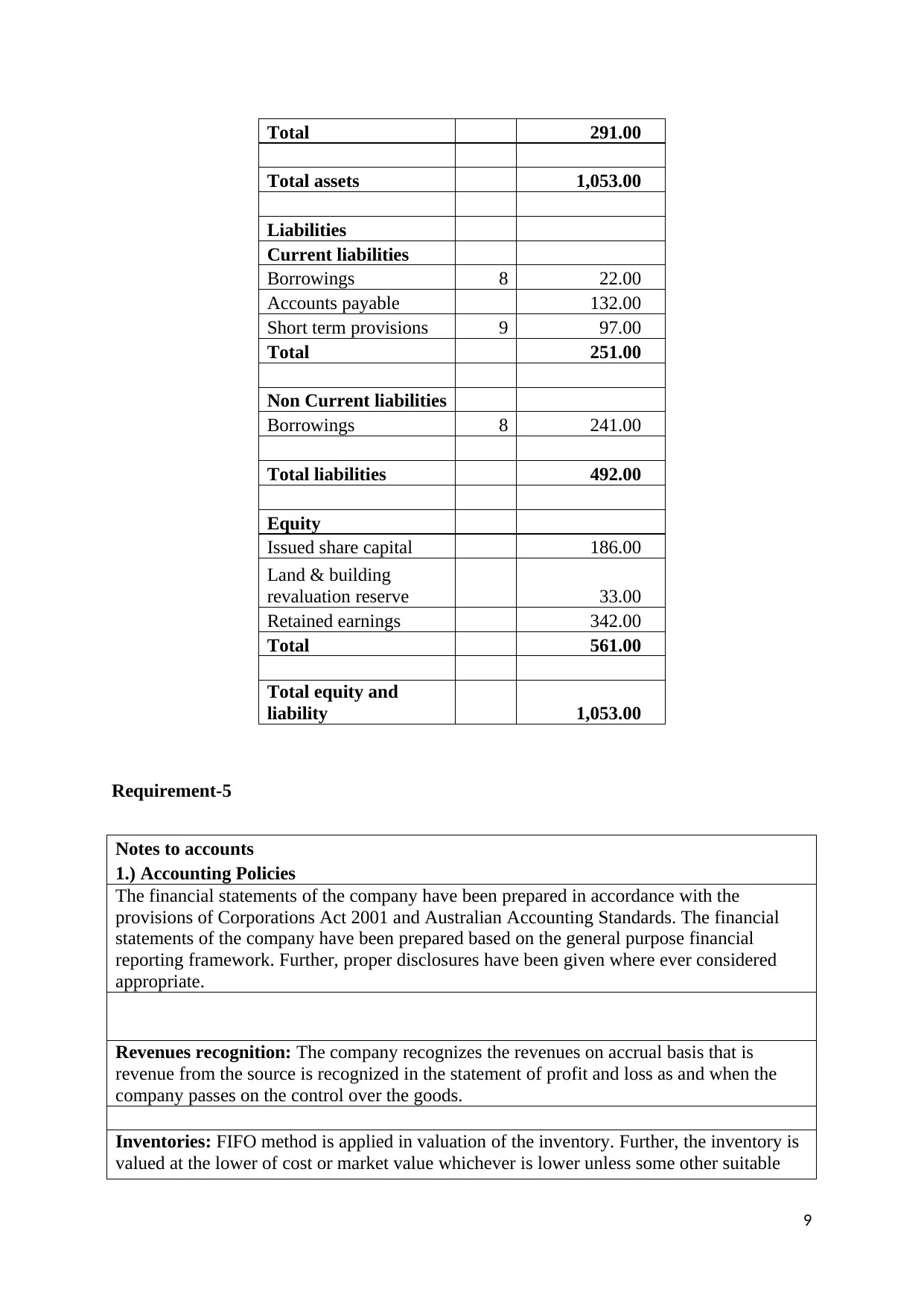
Total 291.00
Total assets 1,053.00
Liabilities
Current liabilities
Borrowings 8 22.00
Accounts payable 132.00
Short term provisions 9 97.00
Total 251.00
Non Current liabilities
Borrowings 8 241.00
Total liabilities 492.00
Equity
Issued share capital 186.00
Land & building
revaluation reserve 33.00
Retained earnings 342.00
Total 561.00
Total equity and
liability 1,053.00
Requirement-5
Notes to accounts
1.) Accounting Policies
The financial statements of the company have been prepared in accordance with the
provisions of Corporations Act 2001 and Australian Accounting Standards. The financial
statements of the company have been prepared based on the general purpose financial
reporting framework. Further, proper disclosures have been given where ever considered
appropriate.
Revenues recognition: The company recognizes the revenues on accrual basis that is
revenue from the source is recognized in the statement of profit and loss as and when the
company passes on the control over the goods.
Inventories: FIFO method is applied in valuation of the inventory. Further, the inventory is
valued at the lower of cost or market value whichever is lower unless some other suitable
9
Total assets 1,053.00
Liabilities
Current liabilities
Borrowings 8 22.00
Accounts payable 132.00
Short term provisions 9 97.00
Total 251.00
Non Current liabilities
Borrowings 8 241.00
Total liabilities 492.00
Equity
Issued share capital 186.00
Land & building
revaluation reserve 33.00
Retained earnings 342.00
Total 561.00
Total equity and
liability 1,053.00
Requirement-5
Notes to accounts
1.) Accounting Policies
The financial statements of the company have been prepared in accordance with the
provisions of Corporations Act 2001 and Australian Accounting Standards. The financial
statements of the company have been prepared based on the general purpose financial
reporting framework. Further, proper disclosures have been given where ever considered
appropriate.
Revenues recognition: The company recognizes the revenues on accrual basis that is
revenue from the source is recognized in the statement of profit and loss as and when the
company passes on the control over the goods.
Inventories: FIFO method is applied in valuation of the inventory. Further, the inventory is
valued at the lower of cost or market value whichever is lower unless some other suitable
9
⊘ This is a preview!⊘
Do you want full access?
Subscribe today to unlock all pages.

Trusted by 1+ million students worldwide
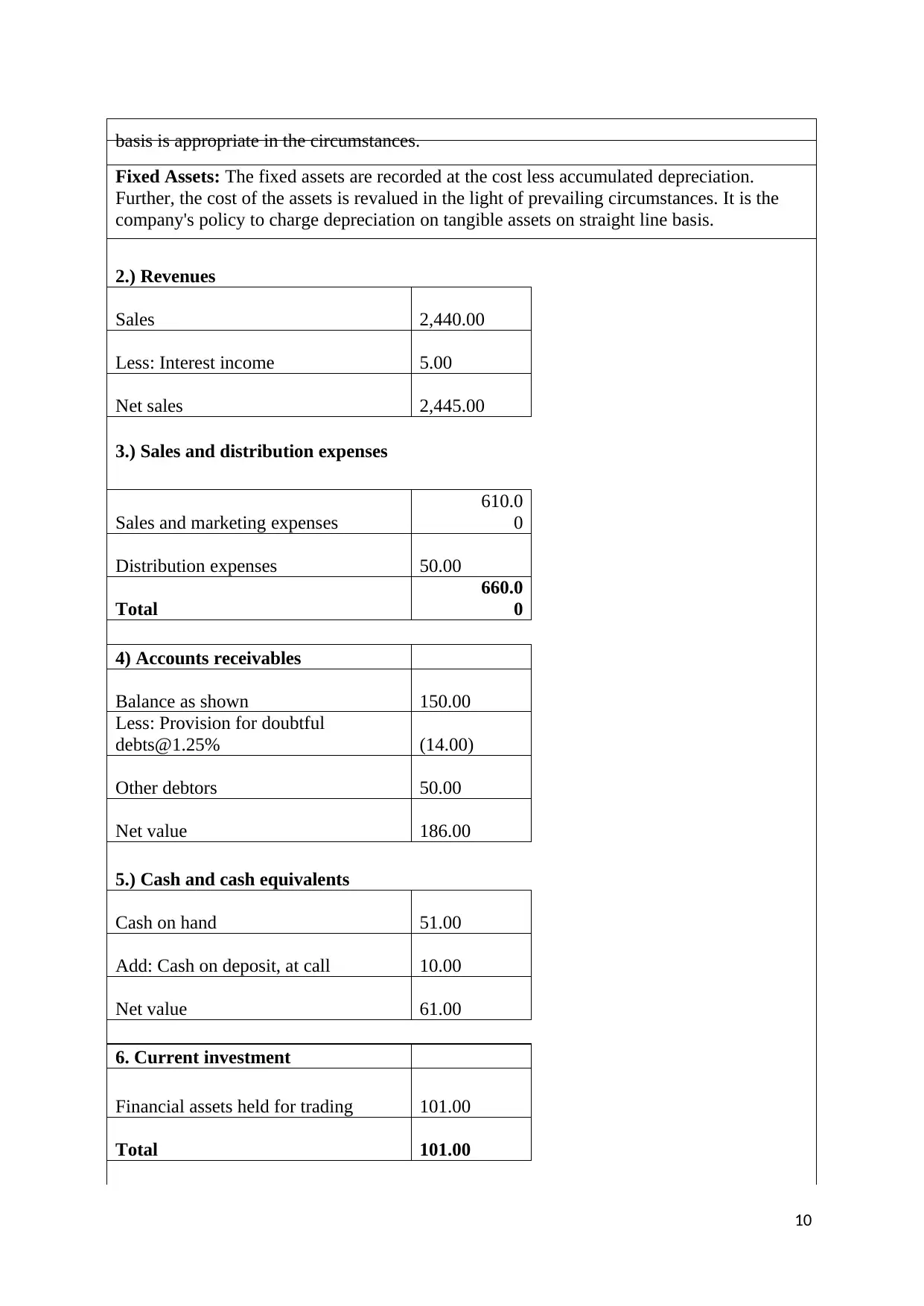
basis is appropriate in the circumstances.
Fixed Assets: The fixed assets are recorded at the cost less accumulated depreciation.
Further, the cost of the assets is revalued in the light of prevailing circumstances. It is the
company's policy to charge depreciation on tangible assets on straight line basis.
2.) Revenues
Sales 2,440.00
Less: Interest income 5.00
Net sales 2,445.00
3.) Sales and distribution expenses
Sales and marketing expenses
610.0
0
Distribution expenses 50.00
Total
660.0
0
4) Accounts receivables
Balance as shown 150.00
Less: Provision for doubtful
debts@1.25% (14.00)
Other debtors 50.00
Net value 186.00
5.) Cash and cash equivalents
Cash on hand 51.00
Add: Cash on deposit, at call 10.00
Net value 61.00
6. Current investment
Financial assets held for trading 101.00
Total 101.00
10
Fixed Assets: The fixed assets are recorded at the cost less accumulated depreciation.
Further, the cost of the assets is revalued in the light of prevailing circumstances. It is the
company's policy to charge depreciation on tangible assets on straight line basis.
2.) Revenues
Sales 2,440.00
Less: Interest income 5.00
Net sales 2,445.00
3.) Sales and distribution expenses
Sales and marketing expenses
610.0
0
Distribution expenses 50.00
Total
660.0
0
4) Accounts receivables
Balance as shown 150.00
Less: Provision for doubtful
debts@1.25% (14.00)
Other debtors 50.00
Net value 186.00
5.) Cash and cash equivalents
Cash on hand 51.00
Add: Cash on deposit, at call 10.00
Net value 61.00
6. Current investment
Financial assets held for trading 101.00
Total 101.00
10
Paraphrase This Document
Need a fresh take? Get an instant paraphrase of this document with our AI Paraphraser
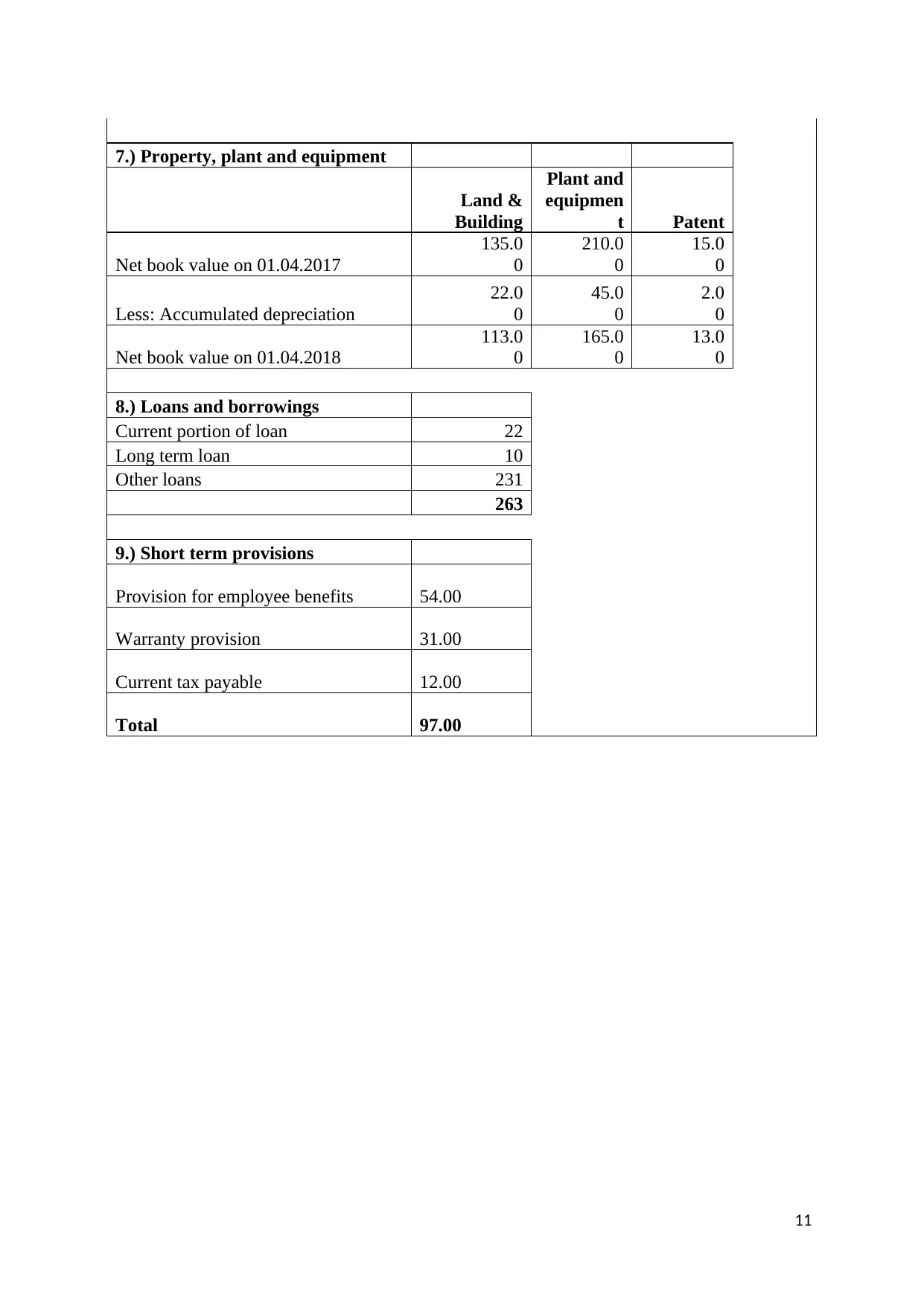
7.) Property, plant and equipment
Land &
Building
Plant and
equipmen
t Patent
Net book value on 01.04.2017
135.0
0
210.0
0
15.0
0
Less: Accumulated depreciation
22.0
0
45.0
0
2.0
0
Net book value on 01.04.2018
113.0
0
165.0
0
13.0
0
8.) Loans and borrowings
Current portion of loan 22
Long term loan 10
Other loans 231
263
9.) Short term provisions
Provision for employee benefits 54.00
Warranty provision 31.00
Current tax payable 12.00
Total 97.00
11
Land &
Building
Plant and
equipmen
t Patent
Net book value on 01.04.2017
135.0
0
210.0
0
15.0
0
Less: Accumulated depreciation
22.0
0
45.0
0
2.0
0
Net book value on 01.04.2018
113.0
0
165.0
0
13.0
0
8.) Loans and borrowings
Current portion of loan 22
Long term loan 10
Other loans 231
263
9.) Short term provisions
Provision for employee benefits 54.00
Warranty provision 31.00
Current tax payable 12.00
Total 97.00
11
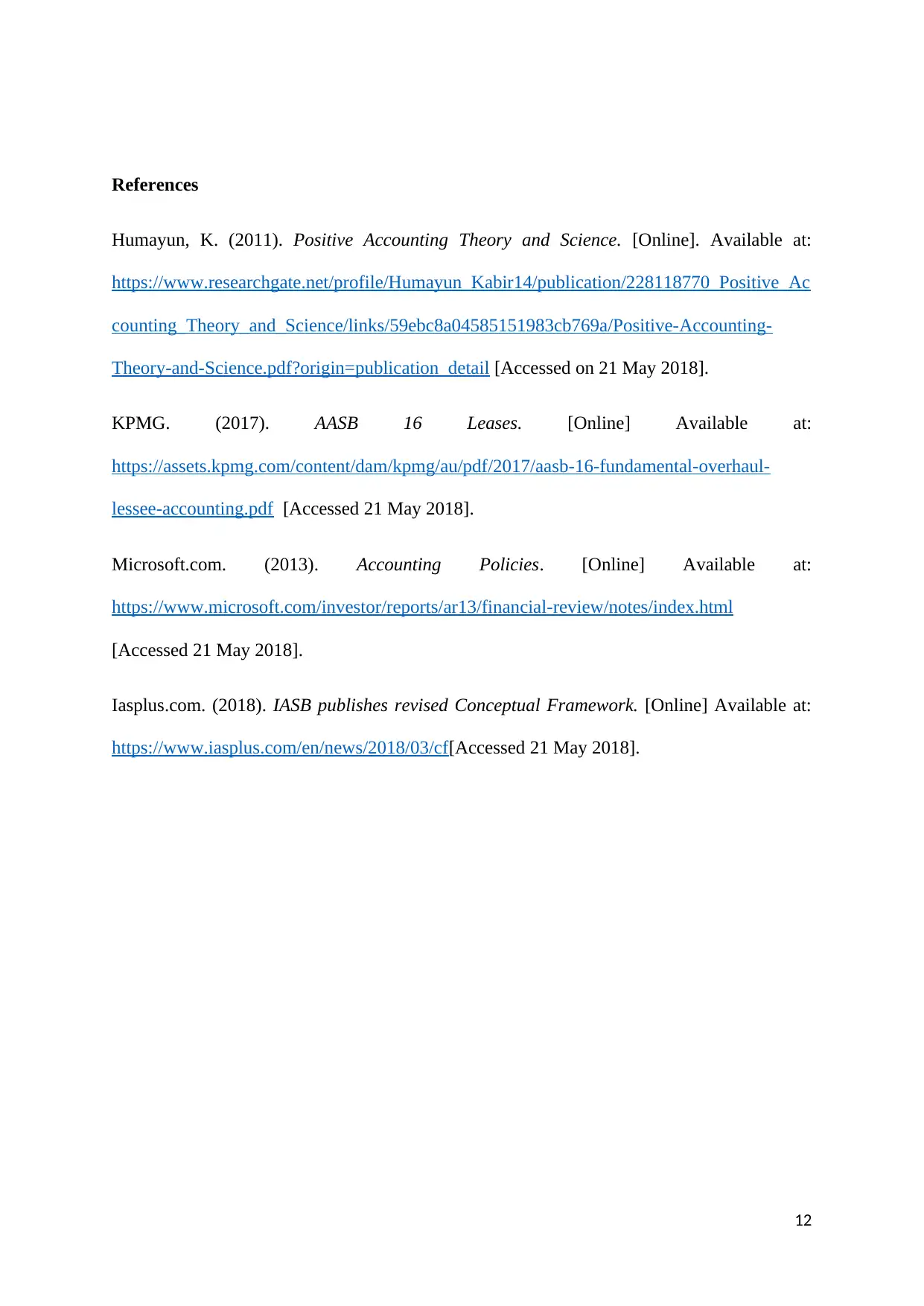
References
Humayun, K. (2011). Positive Accounting Theory and Science. [Online]. Available at:
https://www.researchgate.net/profile/Humayun_Kabir14/publication/228118770_Positive_Ac
counting_Theory_and_Science/links/59ebc8a04585151983cb769a/Positive-Accounting-
Theory-and-Science.pdf?origin=publication_detail [Accessed on 21 May 2018].
KPMG. (2017). AASB 16 Leases. [Online] Available at:
https://assets.kpmg.com/content/dam/kpmg/au/pdf/2017/aasb-16-fundamental-overhaul-
lessee-accounting.pdf [Accessed 21 May 2018].
Microsoft.com. (2013). Accounting Policies. [Online] Available at:
https://www.microsoft.com/investor/reports/ar13/financial-review/notes/index.html
[Accessed 21 May 2018].
Iasplus.com. (2018). IASB publishes revised Conceptual Framework. [Online] Available at:
https://www.iasplus.com/en/news/2018/03/cf[Accessed 21 May 2018].
12
Humayun, K. (2011). Positive Accounting Theory and Science. [Online]. Available at:
https://www.researchgate.net/profile/Humayun_Kabir14/publication/228118770_Positive_Ac
counting_Theory_and_Science/links/59ebc8a04585151983cb769a/Positive-Accounting-
Theory-and-Science.pdf?origin=publication_detail [Accessed on 21 May 2018].
KPMG. (2017). AASB 16 Leases. [Online] Available at:
https://assets.kpmg.com/content/dam/kpmg/au/pdf/2017/aasb-16-fundamental-overhaul-
lessee-accounting.pdf [Accessed 21 May 2018].
Microsoft.com. (2013). Accounting Policies. [Online] Available at:
https://www.microsoft.com/investor/reports/ar13/financial-review/notes/index.html
[Accessed 21 May 2018].
Iasplus.com. (2018). IASB publishes revised Conceptual Framework. [Online] Available at:
https://www.iasplus.com/en/news/2018/03/cf[Accessed 21 May 2018].
12
⊘ This is a preview!⊘
Do you want full access?
Subscribe today to unlock all pages.

Trusted by 1+ million students worldwide
1 out of 12
Related Documents
Your All-in-One AI-Powered Toolkit for Academic Success.
+13062052269
info@desklib.com
Available 24*7 on WhatsApp / Email
![[object Object]](/_next/static/media/star-bottom.7253800d.svg)
Unlock your academic potential
Copyright © 2020–2025 A2Z Services. All Rights Reserved. Developed and managed by ZUCOL.




